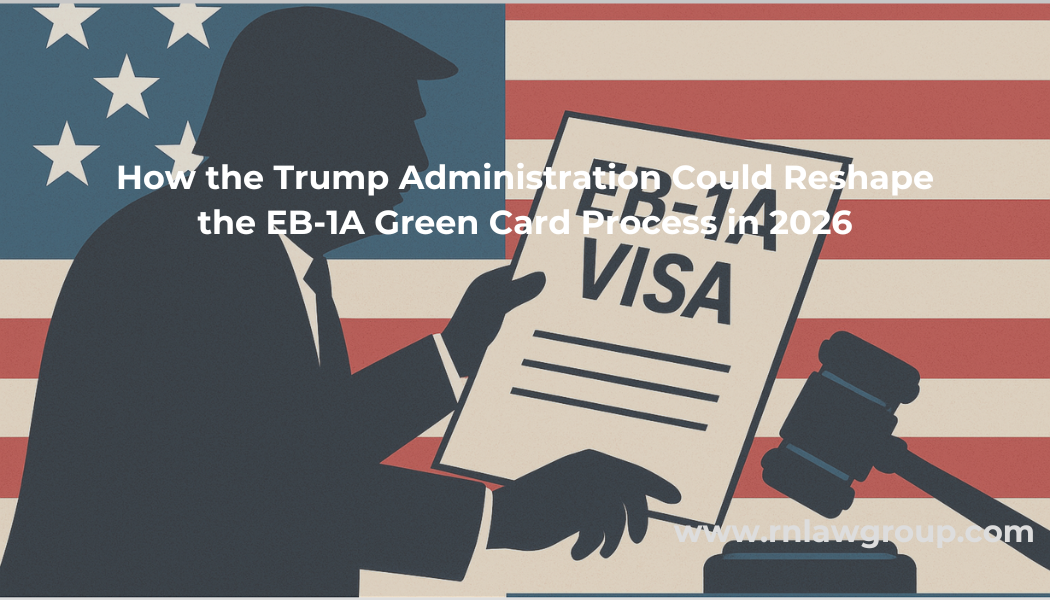
How the Trump Administration Could Reshape the EB-1A Green Card Process in 2026
The EB-1A immigrant visa classification, often known as the “extraordinary ability” category, holds a unique position within U.S. immigration law as it offers a direct pathway to permanent residency without requiring employer sponsorship. This classification honors individuals who rank among the elite few in their respective fields, including science, education, business, arts, or athletics. While this category is established by statute—specifically section 203(b)(1)(A) of the Immigration and Nationality Act (INA)—its interpretation and implementation are significantly influenced by the policies of the executive branch. Given that U.S. Citizenship and Immigration Services (USCIS) functions under the Department of Homeland Security (DHS), any new administration has the potential to substantially alter EB-1A adjudication practices through policy guidance, rulemaking, or operational directives. With the anticipated return of the Trump Administration in 2025, various modifications to the EB-1A process are conceivable, especially considering the administration’s historical focus on safeguarding American workers, enhancing vetting standards, and refining the definition of “extraordinary ability.”
A president does not possess the authority to unilaterally amend immigration laws; however, the executive branch has considerable discretion in their interpretation and execution. The Trump Administration can affect EB-1A adjudications by modifying the USCIS Policy Manual, issuing new policy memoranda, proposing regulations via the Federal Register, or altering processing practices such as interviews, fees, and fraud detection methods. Although these actions are not legislative in nature, they are quite influential. They enable a modification in the evidentiary standards for what is deemed “extraordinary ability” without the need for Congress to enact any new legislation. Nonetheless, alterations that stray too far from established judicial precedents—such as Kazarian v. USCIS, which set forth the two-step adjudication process—may encounter legal challenges. Therefore, the most feasible approach for change would likely involve tightening interpretations rather than dismantling the current frameworks.
A probable path for reform is the amendment of the USCIS Policy Manual, which acts as the main guide for adjudicators. By modifying the examples of acceptable evidence, the administration could create more stringent criteria for petitioners. For example, officers might be instructed to restrict the acceptance of “comparable evidence” to genuinely exceptional situations, thereby discouraging its use as a fallback for weaker categories. The Policy Manual could also enhance the significance of objective metrics—such as quantifiable impact, measurable industry acceptance, or coverage in major, independently recognized media outlets—over subjective letters of recommendation. Under such modifications, letters from close colleagues or internal supervisors may hold less significance unless they are supported by verifiable, third-party documentation. Even minor changes in the wording of officer training materials can significantly influence the culture of adjudication.
Another likely modification pertains to the potential rescission or limitation of the deference policy for petitions that have previously received approval. During the Biden Administration, USCIS reinstated a regulation mandating that officers provide deference to earlier determinations when the facts and parties involved remain unchanged. The Trump Administration may once again revoke this policy, reverting to the approach utilized from 2017 to 2020, where each petition, including renewals or amendments, was thoroughly re-evaluated from the beginning. Such a change would introduce additional uncertainty for EB-1A applicants who alter their employers, job titles, or roles following initial approval. Furthermore, it would grant adjudicators increased discretion to deny cases despite similar circumstances, effectively heightening the burden of proof for consistency across submissions.
The Trump Administration might also consider expanding the requirement for in-person interviews for applicants seeking employment-based adjustment of status (Form I-485). This practice was initiated in 2017 and subsequently reduced. Reinstating or broadening this requirement would lead to increased scrutiny during the adjustment phase for EB-1A self-petitioners, potentially extending processing times by several months. Officers at field offices could utilize interviews to confirm the legitimacy of achievements, publication records, or claimed roles, thereby adding another layer of review beyond the documentation submitted. Such actions would indicate a return to a security-focused, fraud-prevention approach consistent with the administration’s earlier “Buy American, Hire American” (BAHA) executive order.
One alternative approach to elevate the evidentiary standards could involve the implementation of standardized Requests for Evidence (RFEs) and Notices of Intent to Deny (NOIDs). The USCIS has the capability to swiftly distribute new templates that highlight the necessity for verification of independent recognition, the duration of acclaim, and the authenticity of awards or publications. Officers may be directed to request circulation statistics from journals, confirmation letters from award organizations, or proof of peer selection processes. By concentrating on such “high-fidelity” evidence, USCIS could deter dependence on less stringent or commercially motivated achievements, especially in areas where predatory journals and vanity awards are prevalent. Even in the absence of new regulations, this would transform the characteristics of successful petitions.
Fraud Detection and National Security (FDNS) operations represent another domain where the Trump Administration could exert its influence. FDNS units are capable of enhancing background checks, verifying employment histories, and assessing the authenticity of credentials referenced in EB-1A filings. Although EB-1A petitions are self-sponsored, they frequently contain assertions regarding roles, consulting engagements, or judging in competitions that can be externally verified. Increased FDNS scrutiny could prolong adjudication times and elevate denial rates for applicants who are unable to promptly provide independent verification of their claims. This aligns with Trump’s articulated objective of curbing visa fraud and ensuring that only verifiably top-tier individuals are granted immigration benefits.
Financial and operational modifications are also anticipated. Since USCIS operates on a fee-funded basis, the administration has the ability to implement another fee regulation to raise filing expenses for EB-1A petitions and related forms. Additionally, it may alter the premium processing framework by prolonging adjudication periods or increasing costs. Similar measures were taken in 2024, when DHS elevated premium processing fees due to inflation adjustments. A new fee regulation could be deemed necessary for ‘cost recovery’ or ‘backlog reduction,’ but its consequence would be to render EB-1A applications more costly and potentially less attainable for individuals with limited financial resources, particularly artists and researchers lacking institutional support.
Another subtle yet significant change would involve adjusting the guidance for STEM-focused and O-1A categories. The period from 2022 to 2024 witnessed several policy clarifications aimed at assisting STEM researchers and entrepreneurs in showcasing extraordinary ability. These clarifications included new examples in the O-1A and National Interest Waiver (NIW) guidance that aligned modern innovation metrics, such as open-source contributions or startup funding milestones, with existing evidentiary categories. A Trump Administration could retract or limit these examples, reverting to more conventional measures of distinction such as peer-reviewed journal articles, major industry awards, or long-standing media coverage. This shift would disproportionately impact younger innovators in emerging technology sectors who depend on contemporary indicators of influence rather than traditional academic honors.
In addition to administrative memoranda, the Trump Administration may seek to implement formal regulatory changes. Through the process of notice-and-comment rulemaking, the Department of Homeland Security (DHS) could formalize the Kazarian ‘final merits determination’ into regulation, providing explicit definitions for both positive and negative evidentiary factors. For instance, regulations might indicate that awards which lack independent juried evaluation or publications in non-rigorous peer-reviewed outlets would be assigned minimal weight. Such a regulation would complicate the ability of future administrations to reverse this direction without undergoing another formal rulemaking process. Likewise, the agency could pursue precedent-setting decisions via the Administrative Appeals Office (AAO), selecting representative cases that clarify how specific criteria—such as ‘judging the work of others’ or ‘original contributions of major significance’—should be interpreted. Establishing such precedents would enforce a more stringent approach across all adjudicators.
Changes within the Department of State could reflect the adjustments made by USCIS. The State Department has the capacity to issue new notes in the Foreign Affairs Manual (FAM) directing consular officers to conduct more thorough verification of documentation during immigrant visa interviews. Although this would not impact USCIS’s approval of the I-140 petition, it could introduce additional challenges for applicants completing their processes abroad, especially in terms of verifying academic or award credentials. An increased reliance on ‘administrative processing’ or ‘221(g)’ holds could result in delays in visa issuance for EB-1A beneficiaries located outside the United States.
For applicants, the practical implications of such policies would be significant. Officers may prioritize quantifiable and independent evidence—such as citation metrics, patents currently in use, or coverage by globally recognized media—while undervaluing subjective endorsements. Petitioners would be required to present evidence of ongoing acclaim over several years instead of merely short-term success. An increase in interviews, Requests for Evidence (RFEs), and Notices of Intent to Deny (NOIDs) would likely prolong adjudications, while elevated fees would increase costs. Applicants could no longer depend on previous approvals to ensure future results if the deference policy is revoked. Consequently, EB-1A petitioners would need to prepare their filings with the meticulousness of a legal brief, ensuring that every assertion is independently verifiable and thoroughly documented.
In a more stringent adjudicatory environment, EB-1A candidates should focus on three key elements: competitiveness, curation, and consequence. Each piece of evidence must demonstrate a competitive selection process, oversight by credible authorities, and measurable impact within the field. Media features should originate from reputable outlets with established circulation. Expert recommendation letters should incorporate objective data such as citation counts, market reach, or product adoption statistics. Applicants must also demonstrate continuity of recognition—awards, speaking engagements, or publications distributed over several years—to prove that their acclaim is enduring. If USCIS increases the number of interviews, beneficiaries should practice concise, non-technical explanations of their accomplishments that correspond with the regulatory language in 8 C.F.R. §204.5(h)(3).
The broader context of policy is also significant. The directive from the Trump Administration, titled “Buy American, Hire American,” issued in 2017, primarily targeted the H-1B program but resulted in more stringent reviews across all employment-based visas, including EB-1. This precedent indicates that even in the absence of explicit new regulations, a change in the agency’s tone could lead to increased denial rates and extended processing times. A renewed focus on national security, fraud prevention, and the safeguarding of U.S. workers is likely to influence the interpretation of what is deemed as “extraordinary ability,” especially for entrepreneurs or self-employed petitioners who may be viewed as potential job competitors.
However, the administration’s discretion is not without boundaries. Federal courts have consistently upheld that USCIS is required to adhere to established law and evaluate cases based on the “preponderance of the evidence.” The Kazarian framework, which mandates the fulfillment of at least three criteria followed by a comprehensive final merits assessment, remains legally enforceable. Consequently, while the Trump Administration may narrow interpretations, it cannot legally impose a greater burden of proof than what Congress has permitted. Significant changes would still be open to judicial scrutiny and possible reversal if found to be arbitrary or capricious.
In conclusion, the Trump Administration has the potential to significantly alter the EB-1A process through a series of incremental yet impactful policy measures. It may update the Policy Manual to prioritize objectively verifiable evidence, lessen reliance on previous approvals, reinstate mandatory interviews, intensify FDNS scrutiny, and raise filing fees. Additionally, it could formalize elements of the final-merits test via regulation, establish stricter AAO precedents, and prompt the State Department to implement more stringent visa-issuance procedures. Together, these modifications would not amend the EB-1A statute but would adjust its practical accessibility. For prospective petitioners, achieving success under a Trump-era USCIS would necessitate constructing cases based on measurable, independently verified, and lasting professional contributions. Those who compile their documentation as if defending it in a court of law—clear, consistent, and evidentially sound—will have the greatest likelihood of succeeding in a more demanding adjudicatory environment.
By: Karim Jivani
Karim Jivani is an Associate Attorney at Reddy Neumann Brown PC who focuses on employment-based non-immigrant visas. Karim’s practice covers all phases of the EB-1A and EB-2 NIW visa process including filing petitions, responding to Requests for Evidence (RFE), and drafting motions and appeals. Karim has also worked on all aspects of H-1B, L-1, I-140, and VAWA petitions.

